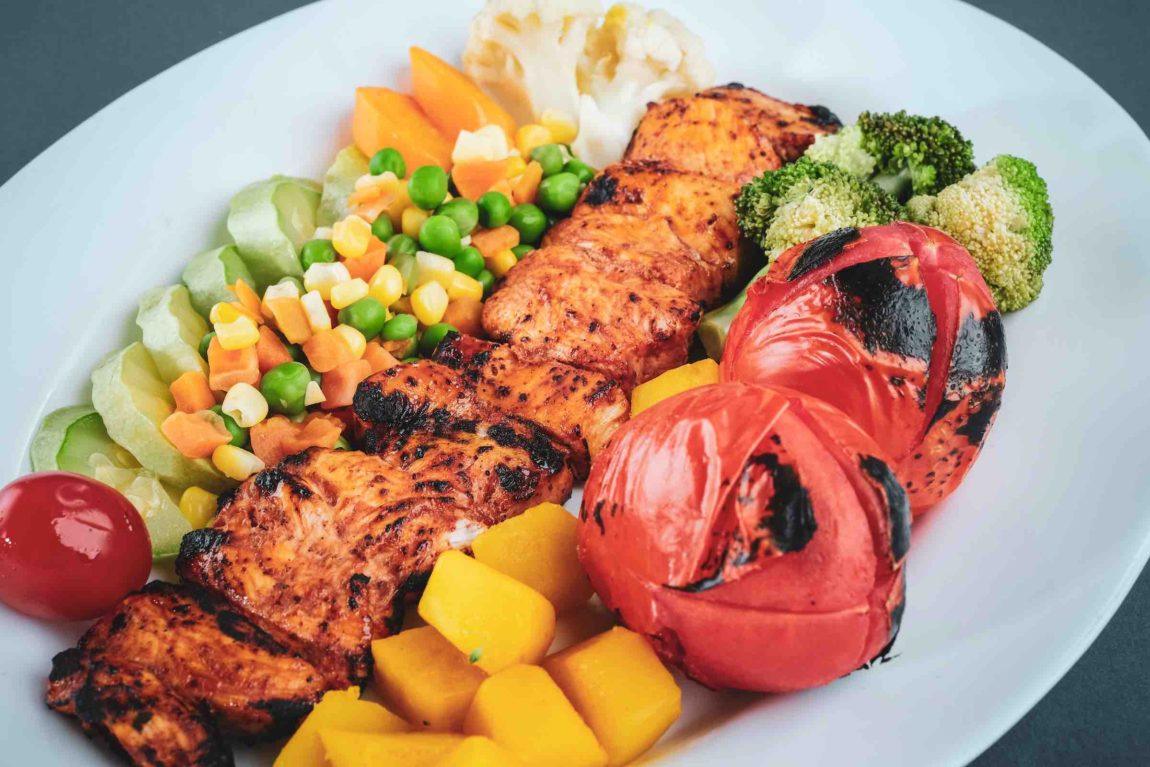I think many people want to eat healthier but when they hear about a plant-based diet, they shy away from it because they don’t want to give up some of the food groups they love, namely meat, fish, and dairy.
But what if I told you that you could change to a mostly plant-based diet – and get the health benefits from it – without giving up meat or those other things you love?
In this post, I’m going to share how it is possible to embrace a more plant-based diet and eat your animal proteins too!
This post contains affiliate links. If you click on one of them, I may earn a small commission (for which I’m very grateful!) at no extra cost to you. You can view my disclosure here.

First Thing’s First – What is a Plant-Based Diet?
A plant-based diet is pretty much what it sounds like. It’s a diet where the primary source of food comes from plants. This means fruits and vegetables but it also includes, oils, nuts, seeds, grains, legumes, and beans.
While many people consider a plant-based diet a vegan diet, that’s not necessarily true. It’s more the other way around. If you’re a vegan, then yes, you’re only eating plant-based foods and nothing in your diet comes from an animal. But in the world of ‘diet lingo’, there are also pescatarians who eat plant-based foods plus fish. And many people who identify as vegetarian will also eat eggs and dairy in addition to plant-based foods.
Lastly, there is the flexitarian approach which is what I’m going to talk about in this post. Flexitarians subscribe to a mostly plant-based diet, (which means the majority of your food comes from plants) but they also occasionally incorporate meat, fish, and dairy.
Honestly, the bottom line is there’s no rule about how you should eat and what you should eat, because there’s no one size fits all approach. So your biggest takeaway from this post – once you’re armed with the knowledge about the benefits of a plant-based diet – is you do you. This is especially important to remember since we are all constantly bombarded by the media and social media with new fad diets and trends. Ignore the noise and do what feels right for you.

What are the benefits of a mostly plant-based diet?
Support Your Immune System
One of the biggest benefits of a plant-based diet is how it supports your immune system. Put plainly, plants contain certain nutrients the human body needs that we can’t get from any other food group. These nutrients help to strengthen your immune system and fight off infection.
Reduce Inflammation
A plant-based diet also reduces inflammation. Phytochemicals and antioxidants, which we get when we ingest plant-based foods, neutralize the toxins in our body from pollution, processed foods, bacteria, and more, which in turn reduces the inflammation in our body.
Maintain a Healthy Weight
Another great benefit of eating a mostly plant-based diet? It will be easier for you to maintain a healthy weight. While exercising and moving your body every day is also a component to maintaining or losing weight (if that’s your goal), what you eat and put in your body is even more critical to your success. If you want to lose or maintain your current body weight, stop eating processed and inflammatory causing foods and stick to a mostly plant-based diet.
Related: My top picks for affordable workout equipment and gear
Your Body Needs Fiber for Healthy Digestion
Last but not least, let’s talk about fiber. The more plant-based foods you eat, the more fiber you ingest which helps maintain a healthy gut. And a healthy gut means you’re body can better absorb the nutrients it needs to function more optimally. Fiber also helps with smoother bowel movements. As my close friend’s mother says, ‘an apple is nature’s version of a broom!’

How to Eat a Plant-Based Diet that Includes Meat
Now, onto the good stuff!
You’re ready to embark on a healthy journey of eating better. You know that will include more vegetables and fruit, but you’re just not ready to give up meat, fish, and/or dairy. (Or you never want to give up these food groups.) That’s ok! It’s still possible to do both.
How?
The trick is changing the way you think about meals and the proportions of these food groups.
What does that mean?
Moving forward, the star of your plate should be plant-based foods, and meat, fish, and dairy should play a supporting role. A good rule of thumb is that at least half of your plate (if not more) should be filled with vegetables. (And not vegetables slathered in butter, cooked in cream or other fattening sauces. You want to eat raw, or lightly steamed/sauteed vegetables to get the maximum benefit.)
The key to success with this is by finding ways to add more vegetables, nuts, seeds, and whole grains to your meals while reducing the amount of animal protein and processed foods.
So, instead of having a large piece of steak with a side of potatoes and green beans, fix yourself a large salad with lots of veggies, and add some sliced steak to it. Or, maybe that means a breakfast burrito filled with beans, avocado, and veggies, with an egg, versus fried eggs with hashbrowns and toast.
If you’re part of a household that eats meat every day, swap out one dinner a week for a vegetarian meal. #Meatlessmondays has become a big trend on social media which could help motivate and inspire you with new, vegetarian recipes.
Related: Changing to a plant-based diet boosted my health and happiness

Another way to successfully change to a mostly plant-based diet is to think about eating the rainbow. When you’re creating your mostly vegetarian meals, choose many colors when it comes to your vegetables to ensure a variety in terms of taste and nutrition.
My last tip is to think about substitutes you can make to add more veggies to your plate. This is also a great trick if you have kids who are picky eaters and don’t want to eat their veggies.
Add pureed vegetables to pasta sauce. Swap out regular rice for cauliflower rice. Or, one of my favorite hacks, use a plant-based meat alternative the next time you make chili, instead of ground beef or turkey. My favorite these days is Beyond Burger and I always break up their patties to add to my chili.
Plant-Based Cook Books for a Mostly Plant-Based Diet
Below is a list of the plant-based cookbooks I recommend for plant-based recipes. Some of these cookbooks, like the ones that focus on a Paleo diet, already include meat. Others are strictly vegan. Don’t freak out about that!
Remember that when it comes to recipes, even if something is vegan, you can always add grilled chicken or steamed fish. The bottom line is when it comes to your diet and your kitchen, you get to make the rules! So have fun with these recipes and experiment.
- Thin From Within – recipes to reduce bloating & inflammation plus a 3-day reset
- Nom Nom Paleo – for Paleo and gluten-free recipes, many that include meat
- Deceptively Delicious – Geared towards kids with tips on sneaking veggies into recipes
- The Defined Dish – for healthy and wholesome weeknight meals
- Oh She Glows – for quick, simple, and satisfying plant-based meals
- Inspiralized & Beyond – creative recipes using mostly vegetables
- The Plant-Based Diet for Beginners – to get familiar with plant-based recipes
- Cooking Whole30 – for 150 recipes for Whole 30 and beyond
- The 30 Minute Clean Eating Cookbook – simple whole-food recipes including meat
If buying a cookbook isn’t in your budget right now, take advantage of Pinterest. There are literally millions of recipes posted there. Just do a search with the right keywords to find what you’re looking for.

Inspiration for Mostly Plant-Based Meals
Do you still need inspiration for what to eat on a mostly plant-based diet? Here are some ideas to get you started.
Breakfast:
- A fried egg with sliced avocado and sweet potato
- A vegetable omelet with a side of sauteed greens
- Rolled oats with almond milk, nuts, seeds, fruit, and a dash of honey
Lunch:
- Lentil pasta with grilled chicken, tomato, and broccoli
- A burrito with sauteed onions, peppers, spinach, black beans, and cheese using a bean-based (gluten-free) tortilla wrap
- A colorful salad with grilled salmon
Dinner:
- a grilled steak salad
- salmon teriyaki with sauteed vegetables
- cauliflower fried rice with vegetables, your choice of meat, and an egg
Dessert:
- fruit to satisfy that sweet tooth
- dark chocolate to satisfy your chocolate cravings
- vegan ice-cream
My Favorite brands For a Mostly Plant-Based Diet
Last, but not least, I wanted to share some of my favorite brands and products that I started incorporating in my cooking once I transitioned to a mostly plant-based diet.
Barilla Chickpea Pasta – a great alternative to wheat and gluten-filled pasta
Better than Boullion – to make your soups more flavorful
Bragg Nutritional Yeast – a good substitute for parmesan cheese if you’ve eliminated dairy from your diet
Bragg Liquid Aminos – a great substitute for soy sauce
Beyond Burger – if you are going meat-free for a bit but still crave the taste of a burger or meat, this is a very realistic substitute
No Evil Plant Meat Chorizo – when you want to feel like you’re eating sausage
Protein Powder – This is great to add to smoothies for an extra dose of protein
Almond Milk – a great substitute for milk if you want to cut down on your dairy intake

Are You Ready to Try a Mostly Plant-Based Diet?
So, what do you think about plant-based diets now?
Do you see the benefits and are you ready to give it a try?
What do you think you’ll miss most by transitioning to a diet like this? And what do you think you’ll gain?
Please comment below with your thoughts and any questions you might have.
Remember that our health is a journey, not a destination, so take your time and experiment to find the best diet that works for you!







No Comments